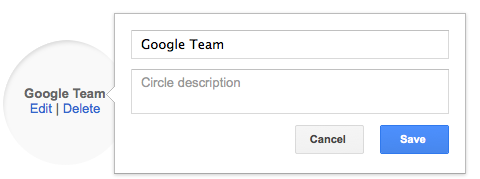So I may have been too focused on a single feature of Google+ in my previous piece, so I’ll continue where I left off. Rather than discussing a feature such as Hangouts, Sparks, and the like in detail, I’m going to focus on the big picture.The big picture is that G+ is severely lacking in user content. The utility of a social network from the user’s perspective is content. Users want to what they’re friends are doing or saying. Think of the badness of MySpace: tons of vacuous celebrity or upcoming film profiles with members but of little actual substances besides gaudy HTML templates and fake spammer accounts.
Based on current trends (again, barely researched and based more on intuition and surface impressions than anything), I don’t see Google+ becoming a viable direct competitor to the “trinity” of social networks it is supposedly replacing- Facebook, Twitter, and LinkedIn. My first reason is that users possess finite time, effort, and patience for social networks. On this point I defer to one infinitely more knowledgeable on this matter than me. The CEO of LinkedIn, Jeff Weiner, has
summed up the dilemma: “All of a sudden, you say ‘Where am I going to spend that next minute or hour of my discretionary time?’ and at some point, you don’t have any more time to make choices.”
And it’s true. The existing social network ecosystem has different networks for different niches. FB for general casual social, LI for professional, Twitter for microblogging (or micro-Tumblring, which would be equal to picoblogging I guess), and never the thrain shall meet. Users do not possess the time to go on redundant networks- who bothers with having both Facebook and MySpace at the same time?
For Google+ to survive, it will have to carve out its own niche, or overthrow any existing social networks. To do so, it will need to offer unique content that will attract users and compel them to create new content. It quickly becomes a chicken and egg issue.
The second reason for the lack of user content is that G+ does not seem to offer many new features. New features allow users to generate new content. But the current offerings seem to be rebrandings of features found in different social networks, and on Google itself. The front page is simply the same as the Facebook newsfeed, LinkedIn updates, etc. Posting updates, sharing items, and so on is the same sort of experience we see in other social networks. The originally-touted killer app was privacy- at this point, Facebook has already covered that, by introducing the option to restrict who gets to see what update.
Despite any shortcomings in these features, Google+ can attract new users in other ways. First, is the weight of the Google brand and the very dream of a “better Facebook” itself. Doubtless many of the users who joined are people interested in checking out something that aspires to be the next social network, created by the titans of Google. Amazingly, the hoary “this is a Beta, invites only!” policy still propels viral transmission despite having been used again and again by Google.
Next, Google+ taps into all of Google’s other features by giving an improved dashboard and integration with other Google options. The company’s m.o. is to get its hands in as many pies as possible, creating a Google X for every thinkable service. (Though, unfortunately, not yet an ISP.) Google+ seems to not simply a social network, but a revamp of Google Profiles. Previously, Profiles were hardly a widely used feature, or a feature that lacked many uses. You create an online Googlecentric identity tied to your Gmail account and others that people can find, and that seemed to be pretty much the extent of it. With G+, your Google identity is actually useful for the other features of social networking besides discovery- you can connect with people, broadcast public statuses and posts to them, Hangouts, etc. By having a singular, defined identity, you can have all of your Google accounts consolidated to one location. Perhaps that is the reason why the system is named Google Plus, rather than Google Circles or Google Social or Google Faces or Orkut+. G+’s aim is not only be your social network, but a better way to access your Google everything’s. Ideally, this would improve your Google experience, encouraging you to spend more time on Google+, generate more user content, which would lead to more pageviews so the ad gods are happy and Google makes money.
But the first way does not guarantee user content- how many of these new G+ accounts translate to accounts that are actually used on a regular basis? And the second way may actually be a liability. Consolidation can lead to alienation. Consider the whole snafu with the real name policy. Even before that, mandating that Google Profiles are to be made public or deleted. This is Google micromanaging user behavior in order to drive consolidation of accounts. If you’re going to tie your Google Profile to a social network, we can’t have fake bot accounts now can we? Why not make it easier to track your Google content by attaching your real name to them? But despite these good intentions, this sort of policy only angers the public. Think random FB site redesigns, except worse because you’re dealing with privacy issues here.
That said, I do enjoy the integration with other Google products, particularly G+’s albums being powered by Picasa. One-click red eye correction beats slightly Orwellian automatic friend tagging any day of the week, and I’m surprised that Facebook hasn’t caught up yet with some limited photo editing functionality.

Possible futures for Google+
Despite my first reason, ironically, I do foresee G+ and FB coexisting despite users having limited time and effort. That’s because far from transforming into the “next Facebook”, I see G+ staying on as a niche network. Google+ will survive in the clanking Google juggernaut by becoming the “group Skype network,” the “Picasa network”, and perhaps as the “nerd network.” The former is because Hangouts and Picasa are superb, and G+ is a good enough frontend to access and manage those accounts as any. The latter is one of my gut impressions. Some of the most popular G+ posts were Tom Anderson’s
thoughtful ruminations on how it fulfills some of his dreams for MySpace. This may be due to my own limited view, but I don’t see any public posts from entertainment celebrities on G+ yet.
Of course, maybe it’s just because the early adopters of G+, an actual viable alternative to FB, a Pallas Athena springing from the forehead of Page-Zeus himself, are nerds and savvy social network power users. Tom Anderson showing up and getting a lot of buzz is a natural consequence, as opposed to Kim K. or Kanye. I’m not sure who were the first big celebrities on Twitter, but I doubt it was Ashton Kutcher. Unless there is a mass exodus from Facebook, the biggest stars on G+ with publicly read and re-posted notes are likely to be the geek glitterati, the industry insiders, the web essayists.
My view is that most people will continue to use traditional, preexisting networks. G+ will survive, not only in the nerd/tech niche, but also through apps that allow for easy reposting on multiple networks. Think of the utility of Meebo, which allows you to be on multiple chat accounts of multiple protocols in one easy web app. Think eventually of a meta-poster that allows you to Share a story on Facebook, Twitter, LinkedIn, Google+ at the same time. Or Like, +1, InShare, Tweet, Digg, Reddit simultaneously. (Gone are the days where there’s a mosaic of share buttons on the bottom of every article!) Ultimately, the real killer app for social networking is to simply bridge all of your current networks together. The upcoming G+ API is only the beginning.
And that would be true consolidation, not simply a Google Profiles+.














































